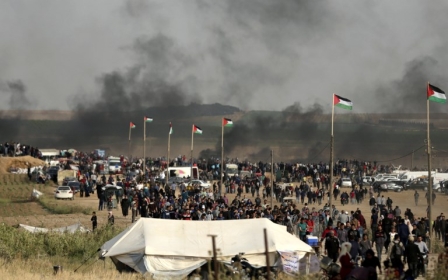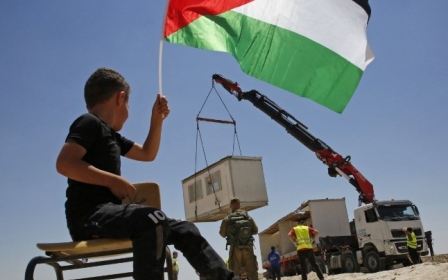Gaza’s Great March of Return: Six months on, we are still struggling against Israeli oppression

Friday 19 October marks the 30th consecutive weekly gathering of thousands of Palestinian women, men and children near the Gaza fence.
These past six months of peaceful gatherings posed no security threat to the Israeli soldiers protected by armoured jeeps and sand barriers beyond the barbed fence. These soldiers could have dispersed the demonstrations with tear gas; instead, they used live bullets, killing more than 200 peaceful demonstrators and injuring around 10,000.
Many were injured in their legs, resulting in scores of disability and amputation cases. The high number of victims posed an additional challenge for medical crews, already suffering from severe shortages of supplies as a result of the siege imposed by the Israeli occupation for more than a decade.
Spreading protests
Despite the bloody fallout, all indications point to the continued momentum of Gaza's Great March of Return. Last Friday, thousands of demonstrators gathered in the five encampment areas. Israeli soldiers killed seven of them.
The demonstrations are no longer limited to Fridays, but have extended to include Mondays and Wednesdays, with activities spilling into the night as young demonstrators conduct nightly protest activities near the fence. Protests have spread beyond the encampments, with a demonstration area near the Beit Hanoun crossing now active.
Every new victim of occupation bullets deepens the wound. Each of the martyrs killed by Israeli soldiers has left a vacuum in the lives of their loved ones
Forms of protest have evolved to include launching boats into the sea north of Gaza, both as a means of defiance and to remind the world of the plight of Palestinians in the world's largest open-air prison.
Thirty weeks into the Great March of Return, it is evident that a powerful motive lies behind Palestinians' determination to push forward with protests, despite the heavy toll exacted by the occupation as punishment.
The continued momentum shows that the environment that instigated these protests six months ago has not changed, and that all promises made to improve the humanitarian situation in Gaza lack credibility for Palestinians living in the coastal enclave.
What do demonstrators want?
Palestinians in the Gaza Strip face two scenarios: to die slowly and quietly as a result of the siege, collapse of medical services, high unemployment, restrictions on movement, salary cuts and economic collapse; or to die loudly, with the world hearing their screams and demands for freedom, dignity and liberation.
The continued gathering of tens of thousands of Palestinians under these conditions should provoke international decision-makers to ask: what do they want? What pushed them into the arms of danger to continue these demonstrations?
More than two-thirds of Gaza's population is made up of refugees forcibly evicted from their homes by Zionist gangs during the 1948 Nakba ("catastrophe"). UN Security Council Resolution 194 stipulates that they should be able to return to their homes, and the ongoing demonstrations fall under the umbrella of this longstanding international resolution. The protesters' lone demand is the implementation of international justice.
Endless grief
Since the Great March of Return turned into a major movement in Gaza, Palestinian factions have agreed on a tactical objective: to break the unjust siege. Israel, which enjoys international impunity, does not recognise the legitimate rights of Palestinians under international law, including their right to a dignified life.
It has failed to address the root of the problem, instead continuing its strategy of terror, killing and disproportionate use of force against peaceful demonstrators, whose only crime is their call to end their displacement and life under siege and tyranny.
Israel's deadly response to the protests has exacerbated Palestinians' suffering. Since the movement began on 30 March, Palestinian mothers have lived in endless grief. Every new victim of occupation bullets deepens the wound. Each of the martyrs killed by Israeli soldiers has left a vacuum in the lives of their loved ones.
The slain protesters loved life, and they showed this love by banging on the walls of their giant prison. They refused to live in humiliation and defeat. They chose to die with honour, screaming "no" in the face of occupation and dehumanisation.
- Ahmad Abu Artema is a Palestinian journalist and peace activist. Born in Rafah in 1984, he is a refugee from Al Ramla village. He authored the book Organized Chaos.
The views expressed in this article belong to the author and do not necessarily reflect the editorial policy of Middle East Eye.
Photo: Friends of 15-year-old Palestinian Mohammed Ibrahim Ayoub, who was shot and killed by Israeli security forces during clashes along the Israel-Gaza border, hold up a poster of his portrait by his grave in a cemetery in Beit Lahia in the northern Gaza Strip on 21 April 2018 (AFP)
New MEE newsletter: Jerusalem Dispatch
Sign up to get the latest insights and analysis on Israel-Palestine, alongside Turkey Unpacked and other MEE newsletters
Middle East Eye delivers independent and unrivalled coverage and analysis of the Middle East, North Africa and beyond. To learn more about republishing this content and the associated fees, please fill out this form. More about MEE can be found here.






